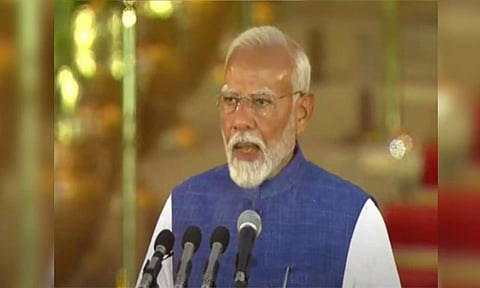

NEW DELHI: The last time India had a three-term Prime Minister was when Jawaharlal Nehru won the 1962 general election. The results must have been a disappointment to him: His party’s tally in the Lok Sabha dwindled from 371 to 361 out of a total of 494 seats. Narendra Modi’s count has just dipped from 303 to 240, and nitpickers might argue that his disappointment ought to be the greater. But then the man himself admitted to nothing of the sort in his speech to the newly elected MPs of the National Democratic Alliance (NDA) last week.
So, in more than a manner of speaking, Modi bears no comparison to Pandit Nehru. Neither does he have Nehru’s numbers going into his third term, nor the temperament to understand his own estrangement from the people’s affections for what it is.Instead, Modi in his 3.0 avatar justifies closer comparison to our previous short-lived Prime Ministers, namely, Charan Singh, Chandra Shekhar, Deve Gowda and IK Gujral, inasmuch as they were propped up, as he is now, by fair-weather friends. Barely months into their reigns, the allies called time on their brief glory and we now remember them as footnotes—although they were all sterling men and deserve better. It has now fallen to Modi, held up by Chandrababu Naidu and Nitish Kumar, to contend with similar uncertainties.
There is no basis really to the notion that coalition rule and lame-duck PMs go hand in hand. After all, in this century, Atal Bihari Vajpayee and Manmohan Singh did make a success of leading minority governments. But can Modi follow in the footsteps of his two illustrious predecessors? Nitpickers will jump up and say, “What about Modi 1.0 and 2.0 then?” That’s an easy one, neither of Modi’s first two terms were true coalitions, and neither successful. That’s why we’re here.
Much of the commentary on the future of Modi 3.0 has centred around the chequered record of M/s Chandrababu and Nitish in being reliable coalition partners. True, Modi’s immediate future depends on him retaining their pleasure. Both are wily masters of leverage politics who know when to drive a hard bargain and when to lie low. They can teach Amit Shah a thing or two about Chanakyan arts. Their immediate demands are likely to be exorbitant. To start with, Naidu’s imperatives as Chief Minister of Andhra Pradesh is to extract special category status for his state. It’s a demand that Modi will find hard to concede, because it’s a measure meant for border states with poor development indices. It’s also a longstanding demand from Bihar, which makes Modi’s balancing act that much more delicate. Then there’s the demand from Nitish that the Agniveer scheme be scrapped. Doing so will immediately go down as a victory for Rahul Gandhi, who campaigned hard for it, and yet another loss of face for Modi.
The allies’ fickle loyalties apart, it’s Modi’s own temperament that is the big question mark. Is he the man for a coalition at all? Can a leader, who insists on being the focus of every photograph, one who nudges the speaker aside even in Parliament functions, and walks ahead of the President — can he share the limelight with partners from the provinces? Going into this term, Modi is more beleaguered, within his party and without, than Dutch courage suggests. A blame game between Amit Shah and Yogi Adityanath on the serious reverses in Uttar Pradesh is imminent. The silence from the RSS since the electoral setbacks is becoming ominous. A number of sidelined heavyweights like Nitin Gadkari, Shivraj Chauhan, Vasundhara Raje and ML Khattar are biding their time. And most importantly, the people have been woken from his spell upon them.